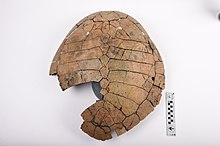| Bothremydidae Temporal range:
| |
|---|---|

| |
| Galianemys Skull | |

| |
| Shell of Taphrosphys | |
| Scientific classification | |
| Domain: | Eukaryota |
| Kingdom: | Animalia |
| Phylum: | Chordata |
| Class: | Reptilia |
| Order: | Testudines |
| Suborder: | Pleurodira |
| Hyperfamily: | Pelomedusoides |
| Family: | †Bothremydidae Baur, 1891 |
| Subfamilies | |
|
See text | |
Bothremydidae is an extinct family of side-necked turtles (Pleurodira) known from the Cretaceous and Cenozoic. They are closely related to Podocnemididae, and are amongst the most widely distributed pleurodire groups, with their fossils having been found in Africa, India, the Middle East, Europe, North America and South America. Bothremydids were aquatic turtles with a high morphological diversity, indicative of generalist, molluscivorous, piscivorous and possibly herbivorous grazing diets,[1][2] with some probably capable of suction feeding.[2] Unlike modern pleurodires, which are exclusively freshwater, bothremydids inhabited freshwater, marine and coastal environments.[1] Their marine habits allowed bothremydids to disperse across oceanic barriers into Europe and North America during the early Late Cretaceous (Cenomanian).[3] The youngest records of the group are indeterminate remains from Saudi Arabia and Oman, dating to the Miocene.[4]
- ^ a b Joyce, WG; Lyson, TR; Kirkland, JI (September 28, 2016). "An early bothremydid (Testudines, Pleurodira) from the Late Cretaceous (Cenomanian) of Utah, North America". PeerJ. 4: e2502. doi:10.7717/peerj.2502. PMC 5045886. PMID 27703852.
- ^ a b Hermanson, Guilherme; Benson, Roger B. J.; Farina, Bruna M.; Ferreira, Gabriel S.; Langer, Max C.; Evers, Serjoscha W. (November 2022). "Cranial ecomorphology of turtles and neck retraction as a possible trigger of ecological diversification". Evolution. 76 (11): 2566–2586. doi:10.1111/evo.14629. ISSN 0014-3820. PMC 9828723. PMID 36117268.
- ^ Pérez-García, A.; Antunes, M.T.; Barroso-Barcenilla, F.; Callapez, P.M.; Segura, M.; Soares, A.F.; Torices, A. (October 2017). "A bothremydid from the middle Cenomanian of Portugal identified as one of the oldest pleurodiran turtles in Laurasia". Cretaceous Research. 78: 61–70. Bibcode:2017CrRes..78...61P. doi:10.1016/j.cretres.2017.05.031.
- ^ de Lapparent de Broin, France; Murelaga, Xabier; Pérez-García, Adán; Farrés, Francesc; Altimiras, Jacint (2018-09-28). "Supplementary information:The turtles from the upper Eocene, Osona County (Ebro Basin, Catalonia, Spain): new material and its faunistic and environmental context". Fossil Record. 21 (2): 237–284. doi:10.5194/fr-21-237-2018. ISSN 2193-0066. S2CID 55783731.